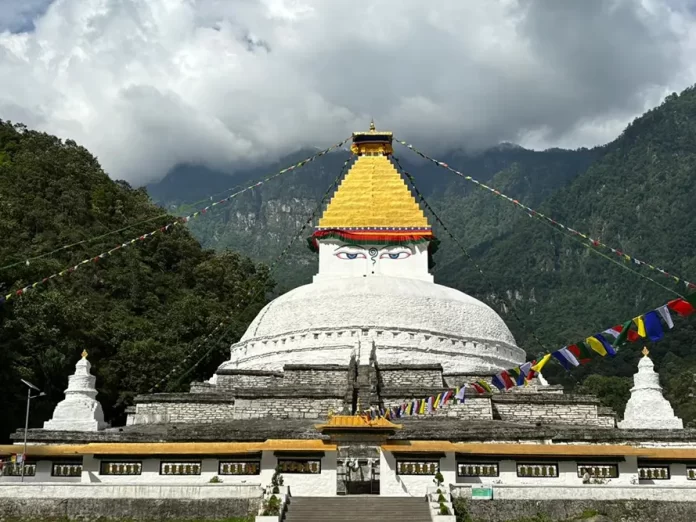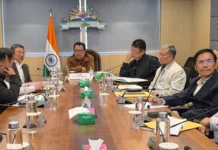[Prem Chetry]
ZEMITHANG, 19 Jun: Pangchen valley, one of the last administrative establishments on the Indo-Tibet border in Tawang district, is emerging as a model for community-led waste management in the Eastern Himalayas.
Zemithang, perched on India’s northernmost frontier, is a region of breathtaking beauty and ecological fragility.
As tourism and urban influences grow, the pressure on land and ecosystems due to unmanaged waste has become a serious concern, Zemithang CO Deewan Mara said.
The EAC office, the Further and Beyond Foundation (FBF), and the Himalayan Fringes Project havelaunched a community-led waste management programme across Pangchen valley.
“The focus is on creating a waste-responsible society, where materials are used wisely, reused when possible, and disposed of responsibly,” the CO said.
What began as a pilot project in a handful of villages has now expanded to 14 settlements, with strong support from local administrators, the Border Roads Organization, and grassroots leaders.
Pooling community support and responsibility, a central material recovery facility (MRF) has been set up, source segregation is practised at the household level, and a monthly ‘Swachhata Diwas’ has been institutionalized.
A user fee system ensures the programme’s sustainability. This effort has been further bolstered by the Royal Enfield Social Mission, which has provided crucial support to strengthen on-ground operations.
The CO said that Zemithang, apart from its historical and religious significance, is also one of the few wintering sites for the majestic black-necked crane -a symbol of spiritual and ecological harmony. Waste here is not just an environmental issue but a cultural one.
To nurture a sense of stewardship from a young age, the FBF runs the Green Guardian School programme as part of the Himalayan Fringes Project.
Under this programme, students in schools, like the Government Middle School in Lumpo, are trained in waste segregation, managing waste banks, and leading regular cleanup drives. These young ‘green guardians’ serve as change agents in their homes and villages.
Simultaneously, village GBs and women’s SHG groups have stepped forward to lead the community clean-ups, track user fee collections, and promote alternatives to disposables. It’s a whole-of-community model, rooted in respect for land, tradition, and collective wellbeing.
“In Zemithang, awareness-building is not a campaign- it’s a conversation, woven into everyday life. Murals, visual signages, community notice boards, and public announcements form the core of a culturally resonant communication approach,” the CO said, and added that workshops and village orientations under the Himalayan Fringes Project (HFP) are conducted regularly by the FBF, supported by school-based activities, SHG meetings, and market sensitization drives.
The administration actively reinforces these messages through local orders and policy circulars.
This layered approach ensures that people not only understand the importance of waste management but also feel a shared sense of pride and ownership in sustaining it.
When asked, the CO said: “Though the vision here goes beyond banning plastic, the focus is on creating a waste-responsible society, where materials are used wisely, reused when possible, and disposed of responsibly.”
Under the Zemithang Valley Waste Management Policy, single-use plastics below 50 microns have been banned and regular collection and transportation to the MRF is ensured.
Recyclables are baled and sent to facilities in Assam.
An eco-tax for tourists visiting sacred zones like Taksang Gompa and Gorzam is also under discussion to build accountability in high-footfall zones.
The strength of this model lies in its sustainability. It is designed to outlast the NGO’s presence, driven by local governance, and rooted in a clear sense of accountability.
Zemithang is proving that even the remotest corners of the country can offer bold answers to global challenges.
With the leadership of its people, the guidance of committed administrators, the vision of the Further and Beyond Foundation, and the support of partners like Royal Enfield Social Mission, this high-altitude valley is transforming into a living model of community-powered sustainability.
The HFP is not just about managing waste; it is about restoring dignity to landscapes and livelihoods. And in that, Zemithang is not behind – it is ahead.
“This is not just a waste management project. It is a cultural shift, led by the people, for the place they love,” said a spokesperson of the FBF.
“Our approach ensures that the system will endure long after we have stepped back.”
By rooting waste management in cultural values, shared responsibility, and systemic thinking, Zemithang is showing that even the most remote regions can become leaders in climate resilience and circular living.




